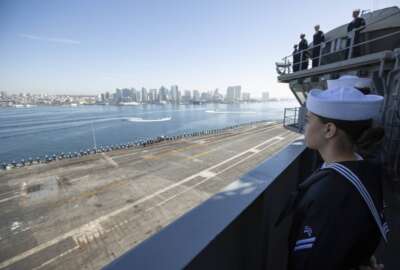Navy grapples with at-sea shortages as recruiting lags
Although retention remains strong, the Navy has thousands of vacancies in its afloat community because of the recruiting slowdown.
Over the past year, the Navy has had, on average, about 18,000 unfilled positions on its ships. The reason is pretty straightforward: There simply aren’t enough sailors in the service because of ongoing recruiting challenges.
In 2023, the Navy missed its recruiting goal by about 7,000 sailors. Nonetheless, officials say the picture appears to be improving: Last year, the service onboarded 6,000 more uniformed service members than it did in 2022, and so far this year, it’s about 2,900 recruits ahead of where it was at the same point in 2023.
But those gains have not been enough to close manpower gaps at sea, Navy Secretary Carlos Del Toro told the Senate Armed Services Committee last week.
“The recruiting effort is all hands on deck, and we may miss our goal by about 6,200 this year,” he said. “I think it’s going to be far less than that, but we actually decided to raise our goal to recruit more sailors this year, unlike the other services. We set our goal at 40,600 because of the shortfalls that we have at sea.”
Navy about 21,000 personnel smaller than three years ago
According to official DoD statistics, the Navy is still shrinking despite some improvements in recruiting figures. There were 327,000 active duty sailors in the fleet at the end of March, the most recent figures available. That’s down 5,000 from the same month a year ago, and down 21,000 from 2021.
Del Toro said one of the biggest challenges recruiters are still facing is getting access to high school campuses for in-person recruiting events. That became a huge problem during the COVID pandemic and still hasn’t been fully resolved.
“We’re working very closely with the Department of Education and with schools from across the nation to try to break down those barriers,” he said. “Our recruiters currently are being allowed in two times a year. We want to increase that to about four times a year. I’ve written thousands of letters to high school principals, in fact. It’s the number one challenge we have in terms of getting to the high school students themselves.”
Another recent issue has been DoD’s implementation of MHS Genesis, the new electronic health record system that reached full deployment earlier this year. Officials emphasize Genesis itself is generally working fine — but because of its interconnections with other medical providers’ databases, more past medical issues are being noticed among prospective service members. And each of those needs to be resolved, often with additional paperwork, before a new sailor can move through the recruiting pipeline.
“We’ve had a lot of discussions about Genesis with all of the service chiefs, the [Office of the Secretary of Defense] and the Defense Health Agency to provide feedback about where it is potentially slowing things down,” said Adm. Lisa Franchetti, the chief of naval operations. “I think we’ve made some definite improvements in streamlining the process and reducing the amount of times people have to go back and get paperwork, and DHA continues to take this feedback. It’s a little bit of growing pains with the new system, and we’re really committed to working with DHA to make sure that it gets our recruits into the system as quickly as possible.”
Organizational, policy changes to boost recruiting
The Navy says it’s made several organizational changes to help improve its recruiting numbers. For example, the service elevated the commander of its recruiting command to a two-star admiral position. It stood up a new “Recruiting Operations Center” to help standardize recruiting processes across the service. It raised the maximum enlistment age from 38 to 41. And borrowing an idea from the Army, it created a new future sailor preparatory course to help prospective candidates meet its standards.
But Vice Adm. Rick Cheeseman, the deputy chief of naval operations for personnel, insists none of that means that standards are lowering.
“I’m certain that recruiting will continue to get better as we focus on the data behind it,” he said during a session at the Navy League’s recent Sea Air Space conference in National Harbor, Maryland. “But the Navy is not lowering standards. The standard is you must graduate from boot camp. You must graduate from your A school. Are we allowing more people the opportunity to do that? Absolutely, because we have to and we should. But the standards remain, and we’re confident in our force going forward when we do that.”
Reaching more recruiting “influencers”
As Navy officials have delved into their recruiting data, one thing they’ve noticed is that there’s a very clear correlation between whether someone agrees to join, and whether they’ve been talking with someone other than a Navy recruiter about the possibility of public service. Because of that, officials are also looking for ways to engage with potential “influencers.”
“We’re getting plenty of interest in the United States Navy — where we lose it is with the influencers. It’s become a little bit generational,” he said. “I need everybody who was associated with the military to be able to talk to a young person about service. Our stats are very clear. As we dive into the data, it takes 10 cold calls to get a recruit — a 10-to-one conversion rate. If anybody is actively mentoring that recruit, it’s a seven-to-one conversion rate. If the active mentor is associated with the Navy, it’s a five-to-one conversion rate; 50% better. So we need to be influencing the influencers so that our outreach isn’t just with the younger population. It is with all of us as well and you all can help us play a part with that.”
And Cheeseman said one reason to think that the recruiting crisis is a temporary problem is that once sailors have joined the Navy, they tend to stay. Like the other military services, retention is at near record high levels.
“We are crushing retention in all zones. If I can get a sailor in the Navy, they’re generally staying in the Navy,” he said. “For those with zero to six years of service, we’re at about 117% of our goal. For six to 10 years of service, it’s 100%. And if I can get you past 10, it’s well over 100%. There’s been a culture of, ‘If you cannot deploy worldwide, you gotta go.’ We’re changing that culture. If you can do any job in the Navy, that’s a reason for you to stay, and we welcome you to stay.”
Copyright © 2025 Federal News Network. All rights reserved. This website is not intended for users located within the European Economic Area.
Jared Serbu is deputy editor of Federal News Network and reports on the Defense Department’s contracting, legislative, workforce and IT issues.
Follow @jserbuWFED






